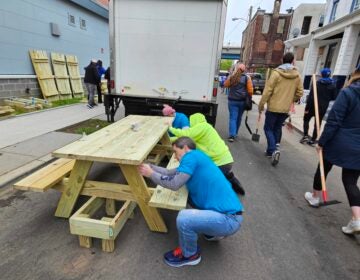Planned Mt. Airy development could be used for communal living
A communal living group is hoping to attract more members in order to turn concept into reality in northwest Philadelphia. Wissahickon Village Co-housing (WVC) is actively trying to increase its ranks in an effort to woo a local developer to build for the co-housing community.
Iron Stone Strategic Capital Partners, Inc. owns a 1.5 acre property at 7048 Germantown Avenue in Mt. Airy, where the former historic Garrett-Dunn house sat before being razed by lightning in 2009.
Six area residents attended an information meeting Monday evening at the Germantown Mennonite Church to hear more about the co-housing concept and WVC’s plans for its future community.
WVC member, Libby Harman stated that the group is “very much in a high gear negotiation” with Iron Stone. WVC hopes to enter into a formal agreement by autumn.
“We’re bringing to the table buyers,” Harman asserted. She explained that building a co-housing community offers the advantage to construct something the developer already knows people will buy.
Harman stated that WVC would need to pre-sell 70 percent of the proposed units in order to seal the deal. Within the next six months WVC members would have to pony up a 10 to 20 percent down payment on their future homes. At present, WVC has 10 households on board.
Communal living in the 21st Century
Iron Stone intends to build 32 homes on the site, 22 houses and a 10 unit condominium building. Harman noted that the housing will include studio, one and two bedroom apartments and 4 bedroom townhouses, ranging in size from 800 square feet to 1800 square feet. Pricing will be at market rate, between $175,000 to $400,000.
How it will work
WVC members will own their units and pay fees to a home owners association, similar to that of a condo association. Members will be able to sell and even rent their purchased units to others. WVC’s home owners association will have ground rules reflective of the group’s ideals which are agreed upon by consensus.
The co-housing model differs from a commune in that there is no leader or fixed power structure, no pooled income or shared business like a farm, and no shared religion or other ideology beyond eco-mindedness and a desire for increased social connection. WVC is structured as a subset of a traditional condominium development, with more common areas and expectation of active community participation. “It’s an intentional community” whose design is “geared towards encouraging contact,” explained Harman.
Communal living includes amenities such as a common house where residents retrieve their mail and can dine together, host parties and otherwise share each other’s company. The common house could potentially hold a shared co-working office, workshop space or guest rooms for visitors. Common areas such a laundry facility, community garden, playground and shared green space could also be key elements in the overall design. Parking would be situated around the perimeter of the site to encourage residents to interact via public walkways.
Design considerations, self-governed committees and task groups as well as conflict resolution are all decided by consensus. Harman said WVC values a multi-generational and diverse population. Members are seeking to build a community where residents can age in place, share child rearing responsibilities and share resources (like a lawnmower) to lessen their carbon footprint.
Currently, WVC’s membership roll includes 10 full-time members eight associate members. Full-time members pay $1000 per year in annual dues, while associates pay only $250. Full-time members have a role in the consensual decision making process and are assigned a number by order of enrollment which gives them an opportunity to choose their unit. Associate members, while not having a say in decisions are able to participate in the group’s ongoing discussions. The dues will be used for consulting, legal and architect fees and are indicative of the optimism WVC has for the project, though Harman said that outlook is guarded. “It’s not a done deal,” said WVC member Janet Boys.
Roxborough was considered
The two year-old WVC originally sought to build a co-housing community on a 3.3 acres site in Roxborough, however, those plans fell through in April 2011. In the mid-1990s, Mt. Airy saw another attempt at co-housing, the Cherokee Home Association, which never materialized.
Boys said that Iron Stone has no prior experience with co-housing, but is open to the idea. According to Boys, there are no architects in Philadelphia who have ever designed for this type of community living space. WVC is currently looking to find a local green design architect who will consult with an experienced out-of-state co-housing architect.
WVC has a wish list, though Boys admits that the group has no idea of the costs involved. Green design elements such as geothermal heating and cooling, green roofs, and building space for parking underneath buildings are some of the things WVC members would love to see implemented in the final project.
The draw of co-housing
For attendees, the idea of communal living makes sense. “It sounds very appealing to me as a possibility,” remarked Chestnut Hill resident, Carol Aronoff. She finds a village concept interesting but shared that she had never been able to spearhead such an effort herself. Being new to the area has left her without a large community circle.
Jenny French, a recent widow whose son is away at college, told the group that she realized that she does not like to live alone. French grew up in Warminster with several friends who lived in nearby Bryn Gweled, a Quaker cooperative community in Southampton. French remembered it as a wonderful place where she often wished she could live. Downsizing and joining WVC is “very tempting,” she admitted.
WHYY is your source for fact-based, in-depth journalism and information. As a nonprofit organization, we rely on financial support from readers like you. Please give today.








